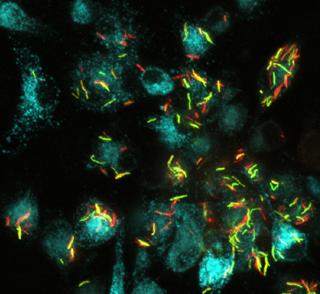Jul 24 2015
A new discovery by Michigan State University scientists suggests that a common medication used to treat glaucoma could also be used to treat tuberculosis, even the drug-resistant kind.
 MSU's Robert Abramovitch developed a biosensor that glows green in response to conditions that mimic TB infection. Credit: MSU photo
MSU's Robert Abramovitch developed a biosensor that glows green in response to conditions that mimic TB infection. Credit: MSU photo
Robert Abramovitch, an MSU microbiologist, along with graduate student Benjamin Johnson who helped lead the study, have discovered that ethoxzolamide, a sulfa-based compound found in many prescription glaucoma drugs, actually turns off the bacterium's ability to invade the immune system.
The research paper is in the current issue of Antimicrobial Agents and Chemotherapy.
"Basically, ethoxzolamide stops TB from deploying its weapons...shutting down its ability to grow inside certain white blood cells in the immune system," Abramovitch said. "We found the compound reduces disease symptoms in mice."
According to Abramovitch, TB may not have eyes and ears, but it has the uncanny ability to sense certain environmental cues in the body and adapt. One of these cues includes the infection's ability to detect pH - or acidity levels - which tells the disease it's being attacked by a host immune cell.
"The compound we found inhibits TB's ability to detect acidic environments, effectively blindfolding the bacterium so it can't resist the immune system's assault," Abramovitch said.
It's estimated that 2 billion people, globally, carry the infection, but in most cases it lies dormant and the immune system is able to prevent it from spreading in the body.
"It's a standoff however," he said. "The immune system has difficulty clearing the infection and the TB bacterium is just waiting for the immune system to weaken."
Abramovitch and his research team screened 273,000 different compounds in hopes of finding one that could possibly stop the disease. By using a synthetic biosensor that glows green in response to conditions that mimic TB infection, something he developed earlier in his research, he eventually found the needle in the haystack that turned the bacterium's sensing ability off.
Yet, this elusive compound not only has the potential of preventing the disease from spreading, but Abramovitch suggests that it could help shorten the length of treatment and slow the emergence of drug resistance, particularly if found to work in conjunction with other existing TB drugs. Current treatments can last up to six months.
"The single biggest reason for the evolution of drug-resistant strains is the long course of treatment," Abramovitch said. "It's difficult for a patient to complete the entire antibiotic course required to kill all of the bacteria. Shortening the duration will help slow the development of these resistant strains."
Trying to kill TB bacteria isn't the only way of stopping the disease though, Abramovitch added.
"We don't necessarily have to find drugs that kill TB, we just need to find ones that interfere with the bug's ability to sense and resist the immune system. By giving the immune system a helping hand, natural defenses can then kill the bacteria."